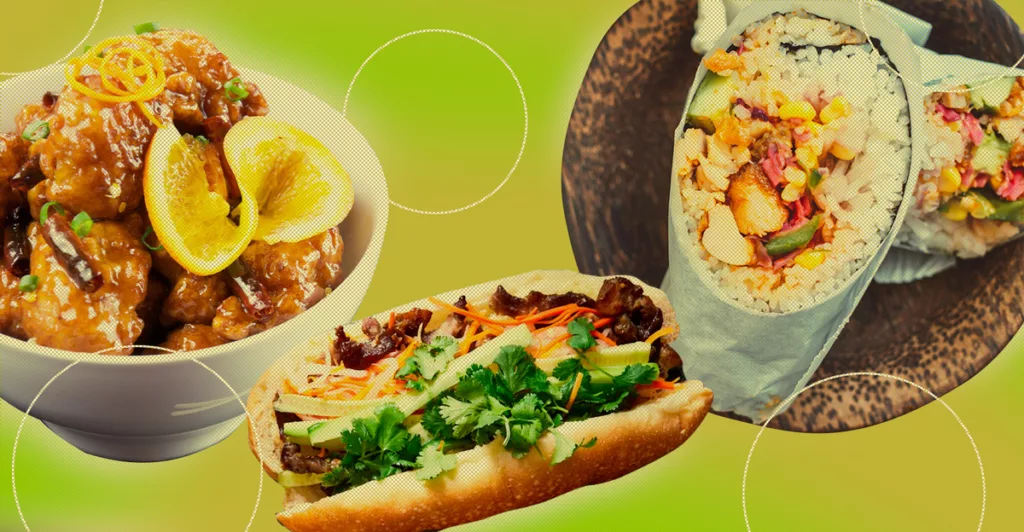EnVi Eatery: Four AAPI Fusion Dishes to Take Your Taste Buds Across Time and Space

“Fusion” is a genre of food dishes in which ingredients and recipes from multiple cultures are merged to form a uniquely-flavored piece. While some are created intentionally, it can also occur naturally through the moving of communities into places with different ingredients. Due to rapid globalization, fusion foods have long enjoyed mainstream popularity and can be found everywhere from street corners to high-end Michelin restaurants. EnVi has compiled the following list of some of the most famous Asian fusion dishes and the unexpectedly deep histories behind them!
Sushi Burritos
Contrary to popular assumptions, sushi burritos were not created by a Japanese-American chef. Rather, the man behind it was Peter Yen, the founder of Sushirrito, a Bay Area restaurant.
“Food, like language, music, and culture, is constantly evolving. To deem something as merely traditional is to shortchange continuous human creativity and innovation,” Yen stated on the Sushirrito website.
Just as the name suggests, Yen combined two of his favorite dishes – sushi and burritos – to infuse the traditional Asian fare with Latin flavors. An avid sushi enjoyer, Yen often found himself between two polarizing sushi options: pre-made grocery that was cheap but low-quality, or full-service sit-down sushi meals that were high-quality but expensive and time-consuming. Sushi burritos hence became the perfect midpoint solution: an efficient wrap of fresh ingredients, just right for a lunch break.
“What would happen if you made a really large sushi roll, operationalized it for speed, and also modernized it by infusing Latin flavors?” Yen posed in an interview with The Manual. The seemingly fun, passing idea soon bloomed into a business — and sushi burritos are now commonly seen near universities and corporate buildings.
California Rolls
The second dish on EnVi’s list also originated from Japanese sushi. This time, however, it was actually created by Japanese-American chefs in Los Angeles during the 1970s. Many Japanese chefs who just arrived in the United States found that the American taste buds of the past were more averse to consuming raw fish. The taste of imitation crab coupled with the buttery texture of avocado, proved to be a great substitute for – and stepping stone to – raw fish. Now, the roll is often seen as a common American Japanese starter dish to ease diners into more ambitious sushi options.
The California Roll was also the first sushi with a “reverse-roll,” where the rice is wrapped around the nori (seaweed). This creative advent was a response to many Americans removing the nori when first introduced to sushi because they thought it was inedible.
Orange Chicken
Perhaps the most iconic and famous Chinese-American dish, orange chicken was first cooked up by Andy Kao after helping launch Panda Express in Hawaii in 1987. Kao was inspired by the islands’ tropical flavors and decided to lather a citrus-infused glaze on top of the all-American classic fried chicken. The original dish also used bone-in chicken, but was soon altered into boneless bite-sized pieces to better satisfy the American palate.
Orange chicken’s success is not without controversy for its cultural roots, especially among the Chinese-American community. Though inspired by Chinese cuisine, the dish itself is native to America and designed for the American taste buds. For Chinese-American cookbook author Grace Young, the greasy and sweet dish, noticeably produced for a white-American audience and commonly found in fast food chains, reinforces the stereotype that “Chinese food is perceived as cheap food.” From guilty pleasure to just plain guilty, the culture of shame surrounding American Chinese individuals enjoying the dish is familiar to many.
“American Chinese cuisine is a separate cuisine from traditional Chinese food, but it is authentic to the immigrant experience, Asian American experience and the Chinese food experience in the U.S,” Jimmy Wang, Panda Express’ Head Chef of Culinary Innovation, said in an interview with NBC News.
Báhn mì
Taking a bite through the simultaneously crispy and fluffy baguette, you are introduced to an explosion of flavors from herbs, pickled vegetables, and aromatic protein. This is Báhn mì (“bun-mee”), a Vietnamese dish born during the tumultuous times of the Vietnam war. It started when the baguette was introduced to the Vietnamese during French colonialism. To “Vietnamize” the bread, the Vietnamese sliced it in half and stuffed it with traditionally Vietnamese flavors. Eventually, Viet chefs learned how to make their own bread, solidifying the Báhn mì as part of Vietnamese food culture.
“They would modify the bread with more yeast and water to make it lighter, for Vietnamese tastes,” Peter Cuong Franklin, Viet-American chef and owner of multiple restaurants across Hong Kong and Vietnam, said in an interview with South China Morning Post.
Years later, the dish is now a symbol of reclamation and national pride, despite its colonial origins. The Báhn mì also followed the many Vietnamese immigrants who sought refuge in the coasts of America after the Vietnam war, and quickly saw success in those American communities as a cheap, easy-to-make, and delicious meal.
According to food journalist Sarah Nguyen in their Medium article, “Bánh mì adds an exotic Asian element to the familiarity of the American diet.” Just like the many other foods mentioned in this list, it’s a stepping stone to Asian dishes with a safety net. Once the Bánh mì arrived in America, the crunchy baguette turned into a softer ciabatta and the Viet mayo was replaced with American mayo.
From being the “Vietnamization” of a french dish to now being an “Americanized” delicacy, the journey of the Bánh mì is an amalgamation of cultural collisions. Though it’s flavors may no longer reflect its origins — depending on the country you are in — the colonial history and immigrant narratives behind the dish should not be forgotten.
Hungry for more food-inspired content? Read more about four women chefs and food content creators here!



